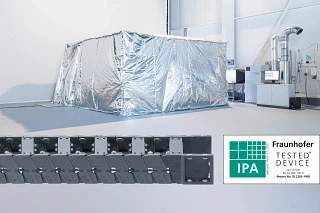Change Language :

Components for battery production
Next level battery manufacturing - particle-free. Self-lubricating. IPA-approved
With the growing demand for electric cars, the need for high-quality lithium-ion batteries is also increasing. Battery manufacturing requires several important criteria. They should ideally be manufactured in dry cleanrooms with minimal humidity and as little particulate matter as possible. Automation is required in this environment because people are not allowed to spend long periods of time in dry cleanrooms. Our cleanroom-compatible and dissipative e-chains as well as our bearing solutions and linear technology are ideal for these environments.
Conductive components for protection against electrostatic discharges and ATEX
Browse cleanroom-approved products
Fraunhofer IPA certifications for the dry cleanroom

Together with the Fraunhofer Institute, we have developed two new certificates that confirm the dry clean suitability of our energy chains in long-term tests: The two new certificates are divided into pre-aging and aging behavior.
The "pre-aging certificate", which we commissioned for our e-skin soft and E14 cable guidance systems, certifies the systems after 15 million double strokes and 10 months in the dry room. Here we received the best possible cleanroom ISO Class 4 certification (see table 2).
Two of our cleanroom energy supply systems, the E6.J and the e-skin flat, were tested over a period of 10 months in continuous operation in the dry room. They completed over 15 million double strokes. The systems were tested and certified for their cleanroom class every two months. The e-skin flat system withstood the double strokes without any problems and received the best possible ISO cleanroom Class 4 certification, while the E6.J was able to maintain this result for 4 months but then dropped a cleanroom class and finished with ISO Class 5 (see table 3).
| Table 1: STANDARD dry cleanroom | v = 0.5 m/s a = 1 m/s | v = 1 m/s a = 2 m/s | v = 2 m/s a = 4 m/s |
|---|---|---|---|
| E6 (IPA report 2303-1408) | ISO 4 | ISO 4 | ISO 4 |
| TRC.ESD + fibre-rod (IPA report 2309-1461) | ISO 4 | ISO 4 | ISO 5 |
| Table 2: PRE-AGING dry cleanroom | v = 0.5 m/s a = 1 m/s | v = 1 m/s a = 2 m/s | v = 2 m/s a = 4 m/s |
|---|---|---|---|
| SKS28 (IPA report 2411-1575) | ISO 4 | ISO 4 | ISO 4 |
| E14 (IPA report 2411-1575) | ISO 4 | ISO 4 | ISO 4 |
| Table 3: AGING BEHAVIOR dry cleanroom | Time / double strokes | |||||
|---|---|---|---|---|---|---|
| Time: After running-in phase | double strokes: 0 | Time: After 2 months | double strokes 3.2 million | Time: After 4 months | double strokes: 5.1 million | Time: After 6 months | double strokes: 7.5 million | Time: After 8 months | double strokes: 10 million | Time: After 10 months | double strokes: 15 million | |
| e-skin | ISO 4 | ISO 4 | ISO 4 | ISO 4 | ISO 4 | ISO 4 |
| E6 | ISO 4 | ISO 4 | ISO 4 | ISO 5 | ISO 5 | ISO 5 |
Contact Us
Questions or product information? Please contact:

Customer Service
Customer Service:
Phone: Monday to Friday from 8 am - 8 pm
LiveChat: 24 hours
Book a Call
Book an Appointment with a Product Expert







